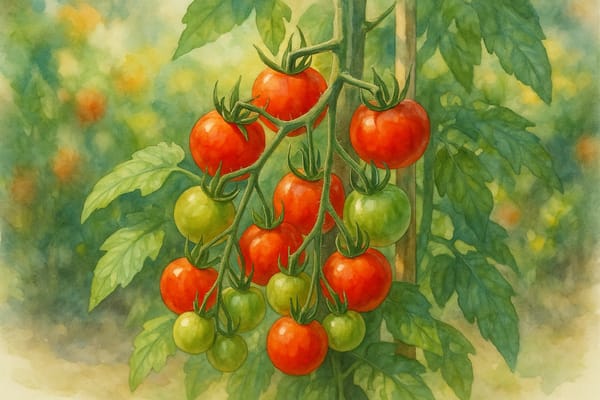Some varieties feel like old friends in the garden — steady, generous, a little nostalgic. Tomato ‘Gardener’s Delight’ is just that. Reliable through the unpredictability of a Cornish summer, this heirloom cherry tomato offers weeks of sun-warmed fruit, trusses tumbling in handfuls from cordoned stems, ready to be picked as you pass with a basket in one hand and secateurs in the other.
This is the tomato for greenhouse benches in March, growbags against whitewashed garden walls in June, and overflowing colanders in August. It doesn’t demand the precision of more temperamental cultivars — just warmth, regularity, and a bit of care.
Sowing Seeds on a Grey Spring Morning
If you’re growing under glass, February through early April is the time to start. For outdoor crops, March to April gives the plants just enough of a head start without racing ahead of the Cornish weather.
Fill trays or pots with a fine, moist seed compost. Sow each seed no deeper than half a centimetre — just a gentle press into the surface, covered lightly with vermiculite or more compost. A warm windowsill or propagator set to 18–21°C will see them germinate in a week or two. Label them carefully — they’ll soon be indistinguishable from the others.
As they break through the surface, a delicate arc of green, shift them into as much light as you can muster. South-facing is ideal. Turn the trays every few days; seedlings will always lean towards the sun.
Potting On as the Days Lengthen
Once the seedlings show two true leaves — not the first pair, but the next set with the shape of a tomato plant — it’s time to give them room. Prick them out gently and place each into its own 7–9cm pot. Handle them by the leaves, never the stem.
Let them grow on in bright, frost-free conditions. Water from below, keeping compost moist but not waterlogged. In these early stages, overwatering is more dangerous than neglect. Once they’ve settled in, begin feeding every 2–3 weeks with a diluted, balanced liquid fertiliser. Think of this as encouragement, not indulgence.
Hardening Off with Patience and a Watchful Eye
By May, they’ll be ready to move outdoors, but not all at once. Cornish gardens can swing from balmy to biting in a single day. Begin hardening off — a few hours outside each day, increasing gradually over a week to ten days. Bring them in at night. Use fleece or cloches if cold threatens.
Transplant in late May or early June once nights are reliably over 12°C. Choose a spot with full sun — at least 6–8 hours daily. A sunny wall, a greenhouse border, or a sheltered raised bed with good drainage will all serve well. If growing in pots, pick a large container and use rich, peat-free compost.
Space plants 40–60cm apart and insert a tall cane or string at planting. Tie in the stem as it grows — it’ll need support.
Training the Plant, and Yourself
‘Gardener’s Delight’ is an indeterminate tomato, which means it just keeps growing — tall, enthusiastic, a bit unruly without guidance.
Pinch out the side shoots that appear between each leaf and the main stem. Do this regularly — they appear almost overnight. This single-stem training keeps the plant open, air flowing, and the energy focused on fruit, not foliage.
As summer unfolds, the plant will flower, fruit, stretch upwards. Once five or six trusses have formed (seven or more if under glass), pinch out the growing tip to stop further upward growth. This concentrates energy into ripening.
Remove lower yellowing leaves as the season progresses. You’re creating airflow, sunlight, and ease of picking — all of which matter when rain and sea breezes swing through even in August.
Feeding the Soil, Not Just the Plant
Once the first truss has set fruit, it’s time to switch to a high-potash tomato feed. Feed every week if growing in pots or bags, every 10–14 days if in the ground.
Always water before you feed — nutrients absorb better into already-moist soil. Keep watering steady and deep. Irregular watering causes split fruit and blossom end rot — not uncommon in the warm-dry-then-wet spells of a Cornish summer.
Mulch around the base to hold in moisture and keep weeds down — seaweed, straw, or composted bark work well and suit the rhythm of the region.
The First Fruit of July
By mid to late July, you’ll see the fruit ripening — deep red, slightly glossy, and just soft to the touch. The flavour will be bright, sweet, and balanced with a tang that’s made this variety a staple since the 1950s.
Pick often — it encourages more. They’ll keep coming until October in a good year, especially under glass. If frost threatens and green tomatoes still cling on, bring them indoors to ripen on a windowsill.
Any side shoots you’ve pinched out? If you root them in moist compost, they’ll grow into new plants — a useful trick if you’ve got space and time for a second crop.
Pests, Predators, and the Weather
Like all tomatoes, ‘Gardener’s Delight’ is vulnerable to the usual suspects:
- Aphids and whitefly — wash off or treat with organic sprays
- Blossom end rot — avoid uneven watering
- Blight and moulds — increase airflow, remove affected leaves, never water foliage late in the day
- Slugs and snails — particularly in wet summers, use copper barriers or hand-pick at dusk
Keep plants well spaced and prune regularly to prevent overcrowding. Ventilate greenhouses well on hot days — Cornish humidity can creep in and linger.
Good Neighbours in the Garden
Tomatoes grow happily alongside basil, garlic, chives, marigold, and nasturtium. These companions attract pollinators and deter pests. Avoid planting near brassicas, fennel, or potatoes, which can compete or harbour diseases.
A Garden Story in Every Fruit
There’s something grounding about the routine of tomato care. The daily watering, the pinching of side shoots, the quiet joy of seeing a green truss slowly shift to red. ‘Gardener’s Delight’ isn’t a show-off, but it rewards you generously — especially if you let the rhythm of the garden guide you.
And when the rains come — as they do in Cornwall, sometimes sideways — you’ll be glad for the handfuls you harvested early that morning, the bowls on the windowsill, the jars of passata set aside for winter. A memory of warmth when the skies darken.











